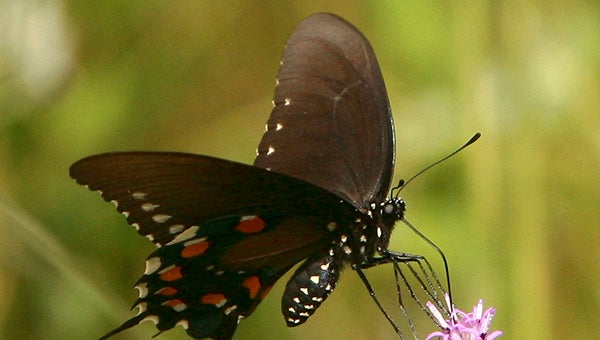Arboretum Paths: Summer insects are bountiful in the bog
Published 7:00 am Wednesday, August 10, 2016

An Eastern Swallowtail butterfly sips nectar from a Liatris bloom in the Arboretum’s South Pitcher Plant Bog (Photo by Lana Gramlich).
Summer is a glorious time of the year for bugs at the Arboretum. When the weather heats up, so does the insect activity!
On a walk down the boardwalk in the south Pitcher Plant Bog, one is immersed in a sea of humming, buzzing, and flitting insect life. The current show along the raised walkway is a bumper crop of cowbane (Oxypolis filiformis).
What a delight to stand among this towering plant, feeling the hum of insect life in the savanna. A variety of insects feed on the flowers. You might also find tiny green lizards on the stems, scooting behind them as you pass, hiding from view.
Cowbane looks a lot like Queen Anne’s lace, a common non-native roadside plant from Asia and Europe, but it is much taller, and grows in much wetter areas. Perhaps you’ve spotted it lately, growing in roadside ditches.
Both plants are in the carrot family, and have wide, white, flat-faced umbels which are actually clusters of many tiny flowers. Parsley, dill, and fennel are also in this same plant family.
For pollinating insects on the hunt for nectar, cowbane’s flat umbels make them attractive destinations, because they provide wide areas to land, and sip nectar. Like mini-helicopter pads!
On Saturday’s walk, swallowtails fluttered among the cowbane, sipping nectar from the orange flowers of tall-stemmed fewflower milkweed.
This is the perennial mentioned in last week’s column, which was unfortunately “rustled” from our bog recently. The removal means a few less stems are available to butterflies searching for nectar.
In observing their flight, swallowtails favored milkweed nectar, instead of the cowbane. What a perfect balance it seems, that these two plants are found growing together under the same conditions.
Nearby, a third plant is developing that will play a future role in the life of swallowtail butterflies. In a drier area, hundreds of Liatris flower spikes are erupting. The attractive native perennial is known as gayfeather or blazing star.
Because cowbane is a host plant for the eastern black swallowtail butterfly, multitudes of hungry caterpillars will soon be feasting on its leaves and stems of these plants. Where do they come from?
Swallowtail butterflies lay eggs on the cowbane. Once they emerge, the tiny caterpillars will begin eating the leaves and stems.
When a caterpillar is ready to pupate, instead of hanging upside down in a “J” as monarch butterflies do, the “cat” secures itself to the stem of a plant by a single silken thread. It then changes into a chrysalis. In about two to three weeks, a butterfly will emerge.
In the bog, new swallowtails will find purple Liatris spikes offering them a nectar “meal”. This will be an excellent “photo op” for nature photographers, as many species of butterflies will be dancing in the Liatris patch!
It also seems to be a bumper crop of dragonflies this year. Over 400 species of dragonflies occur in the U.S., and many of them seem to have made the Arboretum their home. Visitors have commented on these insects – their size, abundance, and variety.
But Dragonflies are not nectar-sippers. They are voracious predators, capturing insects mid-flight, for their well-earned nickname, “mosquito hawks”.
To attract dragonflies to your garden, provide a water source. If you have a water or bog garden, you are certain to find them darting among your plants this time of the year, looking for a meal.
For more information on attracting butterflies, dragonflies, and other beneficial insects to your garden, search by keyword at the MSU Extension Service website at http://extension.msstate.edu/.
Mark your calendars for the Arboretum’s Bugfest on September 16 and 17!
A free program on “Controlling Wild Hogs” will take place on Saturday, August 13 at 10:00 a.m., and a Mushroom Field Walk will be held Saturday, August 20 at 10:00 a.m. This walk is free to members and $5 for non-members, $2 for non-members’ children. Call 601-799-2311 to sign up for programs.
For more information, see www.crosbyarboretum.msstate.edu. The Crosby Arboretum is located at I-59 Exit 4 and open Wednesday through Sunday from 9 a.m. to 5 p.m.
Patricia R. Drackett, Director and Assistant Extension Professor of Landscape Architecture
The Crosby Arboretum, Mississippi State University Extension Service



